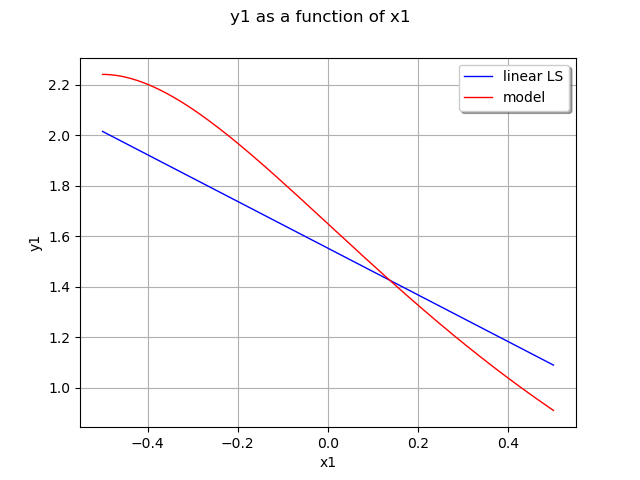Note
Go to the end to download the full example code
Create a linear least squares model¶
In this example we are going to create a global approximation of a model response using a linear function:
Here
import openturns as ot
import openturns.viewer as viewer
from matplotlib import pylab as plt
ot.Log.Show(ot.Log.NONE)
# Prepare an input sample
x = [[0.5, 0.5], [-0.5, -0.5], [-0.5, 0.5], [0.5, -0.5]]
x += [[0.25, 0.25], [-0.25, -0.25], [-0.25, 0.25], [0.25, -0.25]]
Compute the output sample from the input sample and a function.
formulas = ["cos(x1 + x2)", "(x2 + 1) * exp(x1 - 2 * x2)"]
model = ot.SymbolicFunction(["x1", "x2"], formulas)
y = model(x)
Create a linear least squares model.
algo = ot.LinearLeastSquares(x, y)
algo.run()
get the linear term
algo.getLinear()
get the constant term
algo.getConstant()
get the metamodel
responseSurface = algo.getMetaModel()
plot 2nd output of our model with x1=0.5
graph = (
ot.ParametricFunction(responseSurface, [0], [0.5]).getMarginal(1).draw(-0.5, 0.5)
)
graph.setLegends(["linear LS"])
curve = (
ot.ParametricFunction(model, [0], [0.5])
.getMarginal(1)
.draw(-0.5, 0.5)
.getDrawable(0)
)
curve.setColor("red")
curve.setLegend("model")
graph.add(curve)
graph.setLegendPosition("topright")
view = viewer.View(graph)
plt.show()

Total running time of the script: ( 0 minutes 0.070 seconds)
 OpenTURNS
OpenTURNS